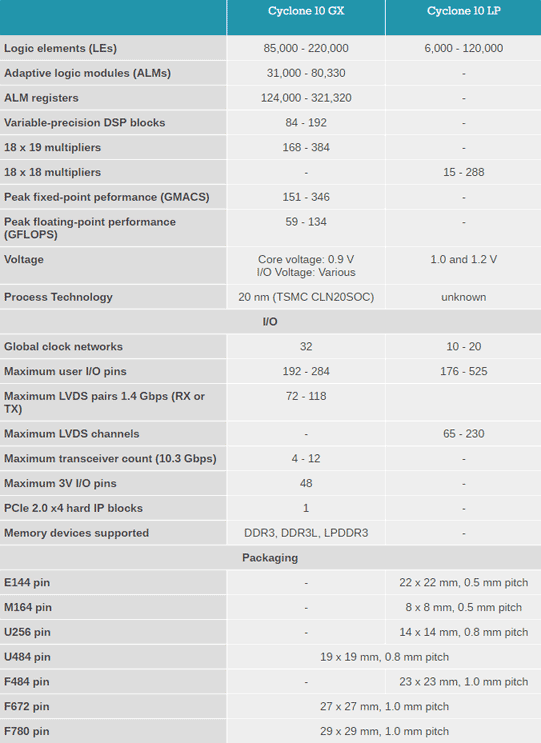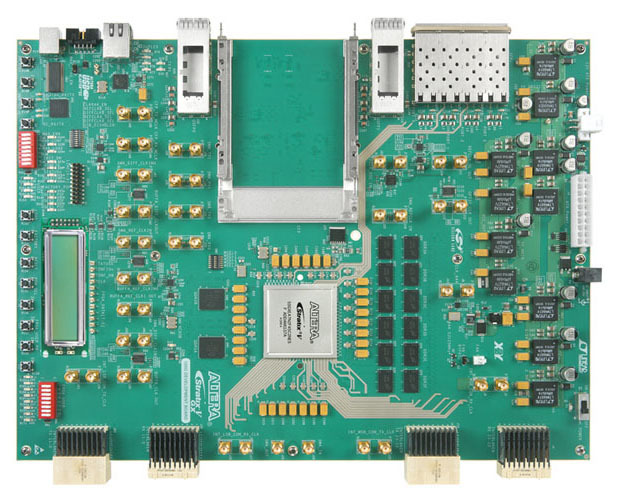Cyclone 10 - FPGA branded Intel
 When in 2015, Intel acquired one of the strongest manufacturers of SoC and FPGA - Altera - no one was surprised. And the point is not that the negotiations on the transaction have been going on for a long time and undulatingly. Too obvious are the advantages that Intel products will receive, and, above all, Altera-enriched processors. The results of cooperation were not long in coming - the “hybrid” Intel Xeon + FPGA has already been announced . And here is the next event: a new generation of FPGA, Cyclone 10, is already released under the Intel brand.
When in 2015, Intel acquired one of the strongest manufacturers of SoC and FPGA - Altera - no one was surprised. And the point is not that the negotiations on the transaction have been going on for a long time and undulatingly. Too obvious are the advantages that Intel products will receive, and, above all, Altera-enriched processors. The results of cooperation were not long in coming - the “hybrid” Intel Xeon + FPGA has already been announced . And here is the next event: a new generation of FPGA, Cyclone 10, is already released under the Intel brand.The Intel Cyclone 10 line consists of two models, significantly different from each other in performance and positioning. The first FPGA, Cyclone 10 GX , provides high performance (up to 134 GFLOP) and advanced I / O capabilities. The matrix contains 220 thousand logical elements, 80 thousand adaptive logic modules (ALM) with 8 input lookup tables (LUT). Connection to other devices can be made via a 10G network port, or via the PCI Express x4 bus. FPGA is made on 20-nm process technology and is designed for computer vision systems, surveillance, video broadcasts, as well as robotics.
The second model, Intel Cyclone 10 LP , takes not horsepower, and energy efficiency and low cost. Its scope is systems with small data streams, such as sensor complexes, engine controllers, and so on. Say, if you need to combine the readings of several sensors, this is exactly the job for Cyclone 10 LP, but to process this data you need something more powerful. FPGA contains 6-120 thousand logical elements, up to 288 multipliers of 18x18, 65-230 LVDS channels. Detailed characteristics of both FPGA - in the plate under the spoiler.
Specifications

Taking this opportunity, I want to remind you of other products manufactured by that part of Intel, which was formerly Altera. These are, first of all, systems on a chip and FPGA (that is, FPGA with and without a processor). The most productive devices are part of the Stratix family (12 nm process technology). Arria - “middle class”, providing a balance between performance and power consumption (technical process 20 nm). The heroes of this post, Cyclone , are positioned as an affordable component of the “Internet of Things” components. Max is CPLD (I mean FPGA) with an integrated non-volatile memory, but at the same time it has a full-fledged FPGA functionality (55 nm process technology). For all these products, boards and development kits are available and, in addition, to facilitate development, there is an Intel FPGA SDK for OpenCL .
')

Stratix V GX 100G Development Kit
It should be noted that the main FPGA / SoC Altera families have not been updated since 2013, which is still quite a lot today. You do not need to be a prophet to assume that in the not too distant future we will learn about other updates with the Intel logo.
Source: https://habr.com/ru/post/401719/
All Articles